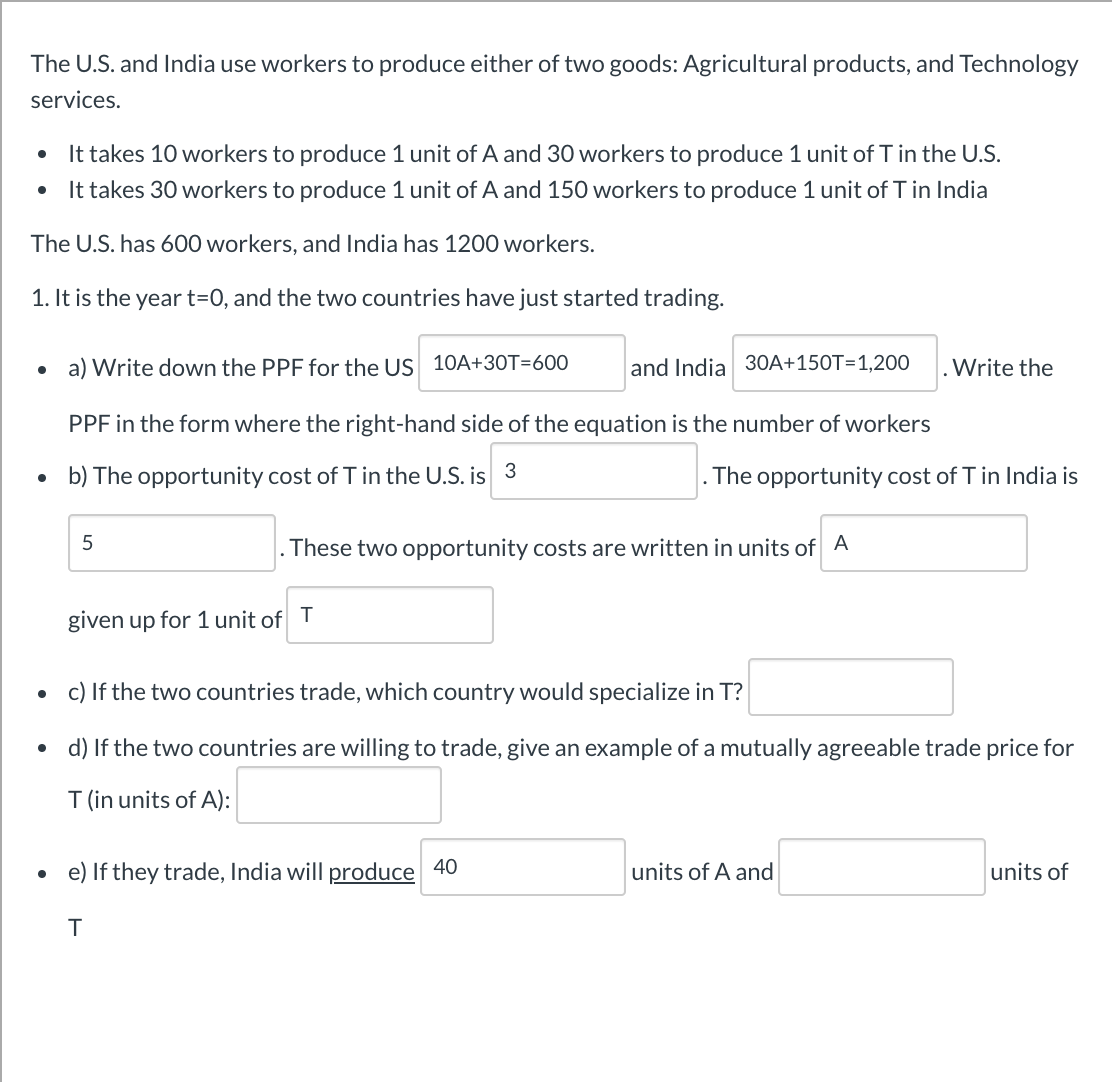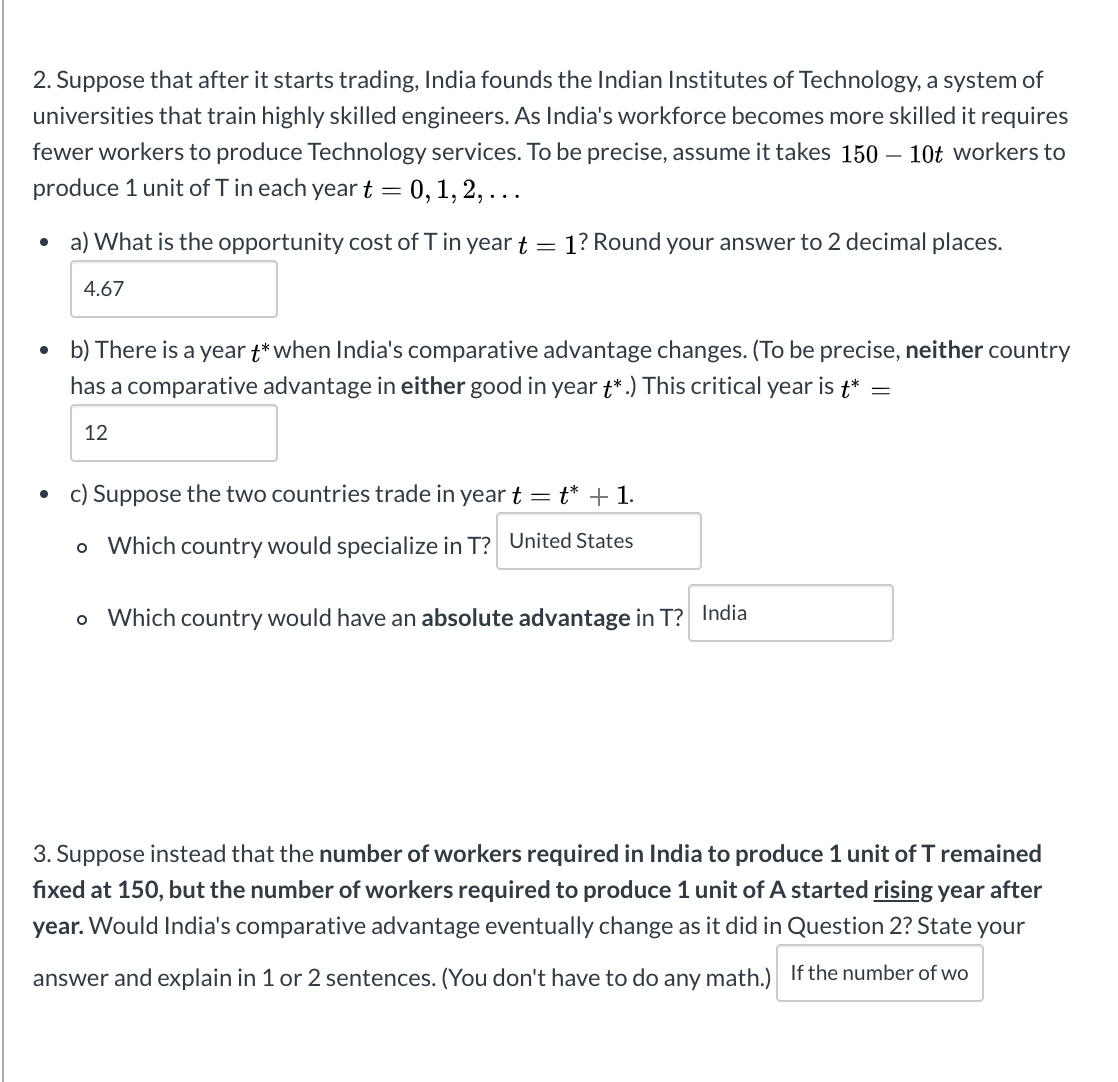The U.S. and India use workers to produce either of two goods: Agricultural products, and Technology services. It takes 10 workers to produce 1 unit of A and 30 workers to produce 1 unit of T in the U.S. It takes 30 workers to produce 1 unit of A and 150 workers to produce 1 unit of T in India The U.S. has 600 workers, and India has 1200 workers. 1. It is the year t=0, and the two countries have just started trading. • a) Write down the PPFE for the US 10A+30T=600 and India 30A+150T=1,200 Write the PPF in the form where the right-hand side of the equation is the number of workers • b) The opportunity cost of T in the U.S. is 3 The opportunity cost of T in India is . These two opportunity costs are written in units of A given up for 1 unit of T c) If the two countries trade, which country would specialize in T? d) If the two countries are willing to trade, give an example of a mutually agreeable trade price for T (in units of A): e) If they trade, India will produce 40 units of A and units of 2. Suppose that after it starts trading, India founds the Indian Institutes of Technology, a system of universities that train highly skilled engineers. As India's workforce becomes more skilled it requires fewer workers to produce Technology services. To be precise, assume it takes 150 – 10t workers to produce 1 unit of T in each year t = 0, 1, 2, ... • a) What is the opportunity cost of T in yeart 1? Round your answer to 2 decimal places. 4.67 b) There is a year t* when India's comparative advantage changes. (To be precise, neither country has a comparative advantage in either good in year t* .) This critical year is t* = 12 c) Suppose the two countries trade in yeart = t* + 1. o Which country would specialize in T? United States o Which country would have an absolute advantage in T? India 3. Suppose instead that the number of workers required in India to produce 1 unit of T remained fixed at 150, but the number of workers required to produce 1 unit of A started rising year after year. Would India's comparative advantage eventually change as it did in Question 2? State your answer and explain in 1 or 2 sentences. (You don't have to do any math.) If the number of wo
The U.S. and India use workers to produce either of two goods: Agricultural products, and Technology services. It takes 10 workers to produce 1 unit of A and 30 workers to produce 1 unit of T in the U.S. It takes 30 workers to produce 1 unit of A and 150 workers to produce 1 unit of T in India The U.S. has 600 workers, and India has 1200 workers. 1. It is the year t=0, and the two countries have just started trading. • a) Write down the PPFE for the US 10A+30T=600 and India 30A+150T=1,200 Write the PPF in the form where the right-hand side of the equation is the number of workers • b) The opportunity cost of T in the U.S. is 3 The opportunity cost of T in India is . These two opportunity costs are written in units of A given up for 1 unit of T c) If the two countries trade, which country would specialize in T? d) If the two countries are willing to trade, give an example of a mutually agreeable trade price for T (in units of A): e) If they trade, India will produce 40 units of A and units of 2. Suppose that after it starts trading, India founds the Indian Institutes of Technology, a system of universities that train highly skilled engineers. As India's workforce becomes more skilled it requires fewer workers to produce Technology services. To be precise, assume it takes 150 – 10t workers to produce 1 unit of T in each year t = 0, 1, 2, ... • a) What is the opportunity cost of T in yeart 1? Round your answer to 2 decimal places. 4.67 b) There is a year t* when India's comparative advantage changes. (To be precise, neither country has a comparative advantage in either good in year t* .) This critical year is t* = 12 c) Suppose the two countries trade in yeart = t* + 1. o Which country would specialize in T? United States o Which country would have an absolute advantage in T? India 3. Suppose instead that the number of workers required in India to produce 1 unit of T remained fixed at 150, but the number of workers required to produce 1 unit of A started rising year after year. Would India's comparative advantage eventually change as it did in Question 2? State your answer and explain in 1 or 2 sentences. (You don't have to do any math.) If the number of wo
Micro Economics For Today
10th Edition
ISBN:9781337613064
Author:Tucker, Irvin B.
Publisher:Tucker, Irvin B.
Chapter17: Growth And Less Developed Countries
Section: Chapter Questions
Problem 2SQP
Related questions
Question

Transcribed Image Text:The U.S. and India use workers to produce either of two goods: Agricultural products, and Technology
services.
It takes 10 workers to produce 1 unit of A and 30 workers to produce 1 unit of T in the U.S.
It takes 30 workers to produce 1 unit of A and 150 workers to produce 1 unit of T in India
The U.S. has 600 workers, and India has 1200 workers.
1. It is the year t=0, and the two countries have just started trading.
• a) Write down the PPFE for the US 10A+30T=600
and India 30A+150T=1,200
Write the
PPF in the form where the right-hand side of the equation is the number of workers
• b) The opportunity cost of T in the U.S. is 3
The opportunity cost of T in India is
. These two opportunity costs are written in units of A
given up for 1 unit of T
c) If the two countries trade, which country would specialize in T?
d) If the two countries are willing to trade, give an example of a mutually agreeable trade price for
T (in units of A):
e) If they trade, India will produce 40
units of A and
units of

Transcribed Image Text:2. Suppose that after it starts trading, India founds the Indian Institutes of Technology, a system of
universities that train highly skilled engineers. As India's workforce becomes more skilled it requires
fewer workers to produce Technology services. To be precise, assume it takes 150 – 10t workers to
produce 1 unit of T in each year t = 0, 1, 2, ...
• a) What is the opportunity cost of T in yeart
1? Round your answer to 2 decimal places.
4.67
b) There is a year t* when India's comparative advantage changes. (To be precise, neither country
has a comparative advantage in either good in year t* .) This critical year is t* =
12
c) Suppose the two countries trade in yeart = t* + 1.
o Which country would specialize in T? United States
o Which country would have an absolute advantage in T? India
3. Suppose instead that the number of workers required in India to produce 1 unit of T remained
fixed at 150, but the number of workers required to produce 1 unit of A started rising year after
year. Would India's comparative advantage eventually change as it did in Question 2? State your
answer and explain in 1 or 2 sentences. (You don't have to do any math.) If the number of wo
Expert Solution
This question has been solved!
Explore an expertly crafted, step-by-step solution for a thorough understanding of key concepts.
This is a popular solution!
Trending now
This is a popular solution!
Step by step
Solved in 4 steps with 4 images

Recommended textbooks for you



